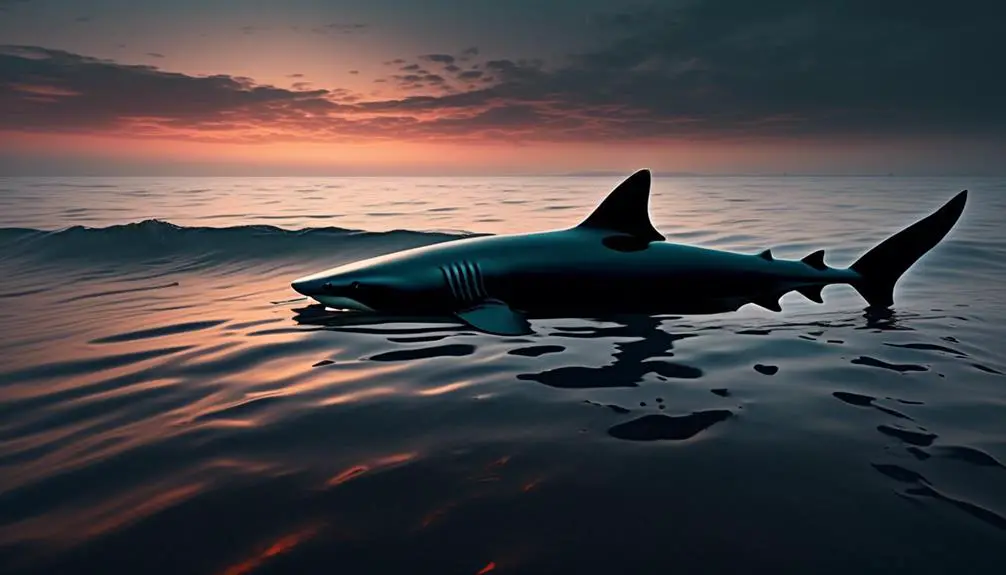Did you know that the Black Sea is home to over 40 species of sharks? Yes, you read that right. Despite its name, the Black Sea is not devoid of these awe-inspiring creatures.
But what exactly are these sharks? How big are they and where can they be found? These questions might be lingering in your mind, and we are here to provide you with all the answers.
So, let’s dive into the mysterious world of Black Sea sharks and uncover the truth behind their existence.
Shark Species in the Black Sea
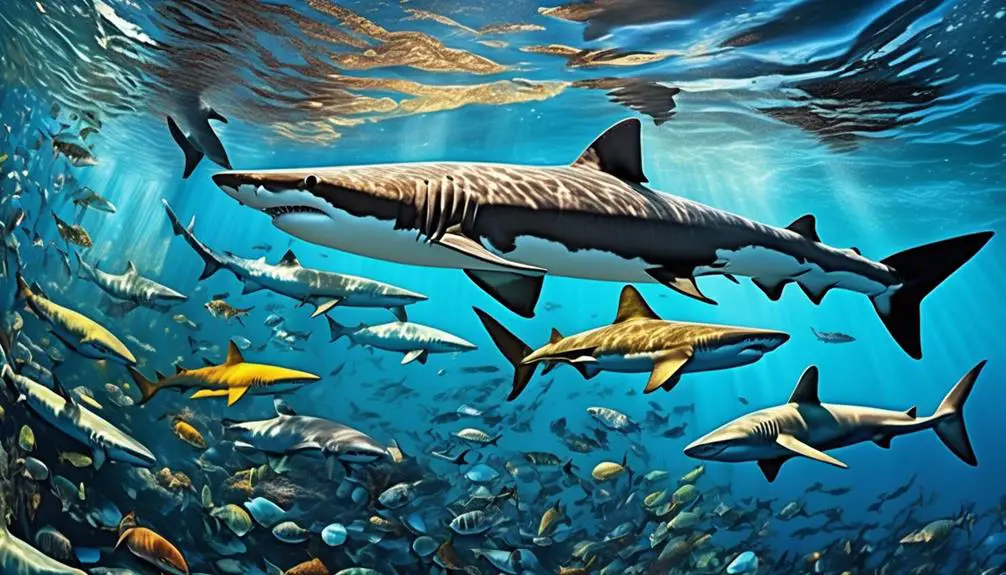
The Black Sea is home to several shark species, with the most common being the spiny dogfish and the common thresher shark.
The spiny dogfish, also known as Squalus acanthias, is characterized by its dull grey-and-brown color scheme and pointed dorsal fin. It’s a small species of shark, typically reaching lengths of around 3 feet.
The common thresher shark, or Alopias vulpinus, is distinguishable by its elongated tail fin, which can be as long as its body. This species is larger than the spiny dogfish, with adults often reaching lengths of up to 20 feet.
Both the spiny dogfish and the common thresher shark have adapted to the specific environmental conditions of the Black Sea. They’re well-suited to the coastal areas and shallow waters of the region. However, despite their presence, encounters with these sharks are rare due to their small population numbers. The limited size and population of Black Sea sharks make them less of a threat to humans compared to sharks in other oceans.
Understanding the shark species in the Black Sea is important for the overall conservation and management of the marine ecosystem. By studying these sharks, we can gain valuable insights into the ecology and biodiversity of the region.
Conservation efforts should be focused on protecting their habitat and ensuring the long-term sustainability of the Black Sea’s marine ecosystem.
Size and Population of Black Sea Sharks

Black Sea sharks are known for their small size and rarity compared to sharks in other oceans. The limited population numbers contribute to the infrequent sightings of these sharks by tourists and researchers.
Despite the common thresher shark being the largest species in the Black Sea, it’s still smaller than other shark species found in different oceans.
Small Size and Rarity
Sharks in the Black Sea, due to their small size and rarity, aren’t commonly encountered by tourists and researchers. The population of sharks in the Black Sea isn’t significant, leading to infrequent sightings. Compared to sharks in other oceans, Black Sea sharks tend to be smaller. Even the largest shark in the Black Sea, the common thresher shark, is still smaller than other shark species found in different oceans.
The limited size and population of Black Sea sharks make them less of a threat to humans. Their small size and rarity contribute to the rarity of encounters with these creatures. Despite their limited presence, studying Black Sea sharks provides valuable insights into the region’s ecology and biodiversity, highlighting the importance of their protection for the long-term sustainability of the marine ecosystem.
Limited Population Numbers
Due to their limited population numbers, sharks in the Black Sea have become a rare sight for both tourists and researchers. The small size and low population contribute to the infrequent encounters with sharks in this region.
The most common shark species in the Black Sea is the spiny dogfish, known for its dull grey-and-brown color scheme and pointed dorsal fin. Another species found in the Black Sea is the common thresher shark, distinguishable by its elongated tail fin. Despite being the largest shark in the Black Sea, the common thresher shark is still smaller compared to other shark species in different oceans.
Sharks in the Black Sea, including the spiny dogfish and common thresher shark, have adapted to the specific environmental conditions of the region. Conservation efforts are necessary to protect the limited population and habitat of Black Sea sharks.
Appearance and Characteristics of Black Sea Sharks
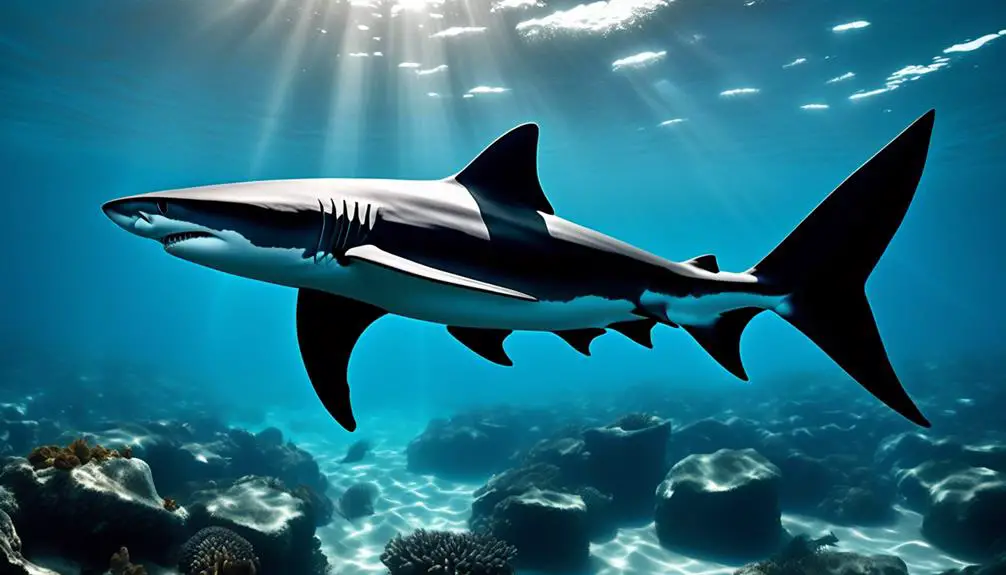
Black Sea sharks, such as the spiny dogfish and common thresher shark, have distinct physical adaptations that enable them to thrive in their specific habitat.
The spiny dogfish is characterized by its dull grey-and-brown color scheme and pointed dorsal fin, while the common thresher shark stands out with its elongated tail fin.
These adaptations, along with other characteristics, allow Black Sea sharks to navigate and survive in the unique environmental conditions of the region.
Physical Adaptations
With their distinct physical adaptations, the spiny dogfish and common thresher sharks in the Black Sea have evolved to thrive in their unique marine environment.
The spiny dogfish, the most common shark in the Black Sea, has a dull grey-and-brown color scheme and a pointed dorsal fin. This coloration allows them to blend in with the sandy and rocky seabed, providing camouflage from potential predators and prey.
The common thresher shark, the largest shark in the Black Sea, possesses an elongated tail fin. This adaptation enables them to swim swiftly and maneuver through the water with ease, making them efficient hunters.
These physical characteristics of Black Sea sharks are essential for their survival and success in their habitat, allowing them to effectively navigate and thrive in the challenging conditions of the Black Sea.
Habitat Specialization
Sharks in the Black Sea exhibit specific characteristics and adaptations that allow them to thrive in their unique habitat. The most common shark species in the Black Sea is the spiny dogfish, characterized by its dull grey-and-brown color scheme and pointed dorsal fin. Another shark species found in the Black Sea is the common thresher shark, identifiable by its elongated tail fin. Black Sea sharks, including the spiny dogfish and common thresher shark, have adapted to the specific environmental conditions of the region. They are generally found in coastal areas and shallow waters influenced by factors such as water temperature and food availability. The appearance and characteristics of Black Sea sharks make them well-suited for their habitat. Conservation efforts are necessary to protect the habitat and population of Black Sea sharks, as they play a crucial role in maintaining the balance of the marine ecosystem.
| Shark Species | Characteristics |
|---|---|
| Spiny Dogfish | Dull grey-and-brown color scheme |
| Pointed dorsal fin | |
| Common Thresher Shark | Elongated tail fin |
Distribution of Black Sea Sharks
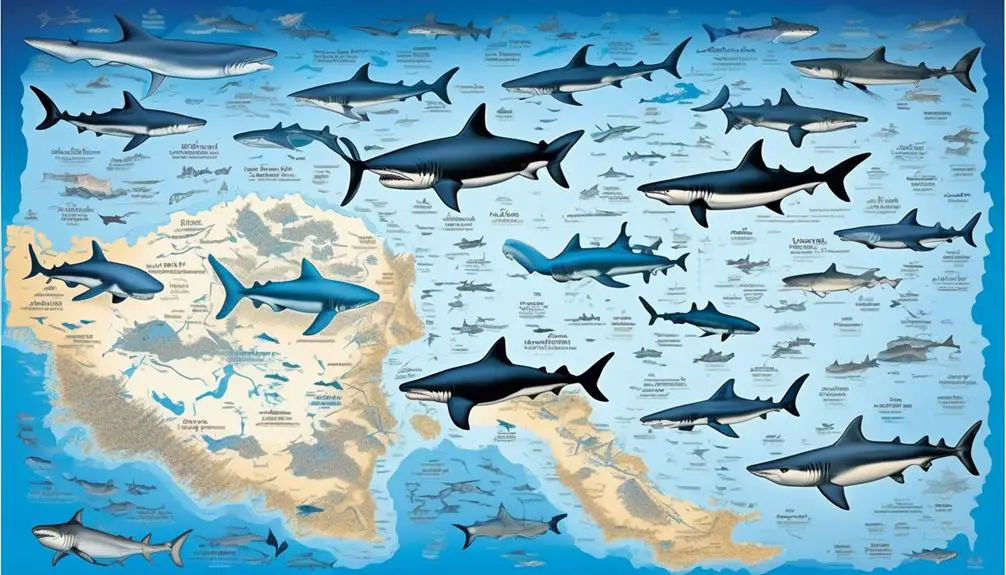
The distribution patterns of shark species in the Black Sea are influenced by various factors, including water temperature and food availability. Sharks in the Black Sea are generally found in the coastal areas and shallow waters. These areas provide an abundance of prey, such as fish and crustaceans, which are essential for the survival of sharks. Additionally, the warmer waters near the coast are more favorable for these cold-blooded creatures, as they rely on external sources of heat to regulate their body temperature.
The Black Sea’s unique geographic characteristics also play a role in the distribution of sharks. The sea is relatively enclosed, with limited connections to other bodies of water. This restricts the movement of sharks and keeps them confined to the Black Sea region. However, it’s worth noting that some shark species, such as the spiny dogfish and the common thresher shark, have been known to venture into neighboring waters on occasion.
Understanding the distribution of sharks in the Black Sea is crucial for the conservation and management of these apex predators. Their presence in the region isn’t only an indicator of a healthy and diverse marine ecosystem but also contributes to the control of fish populations and the regulation of the food chain. By protecting the habitat and population of Black Sea sharks, we can ensure the long-term sustainability of the marine ecosystem in this unique and valuable body of water.
Importance of Black Sea Sharks
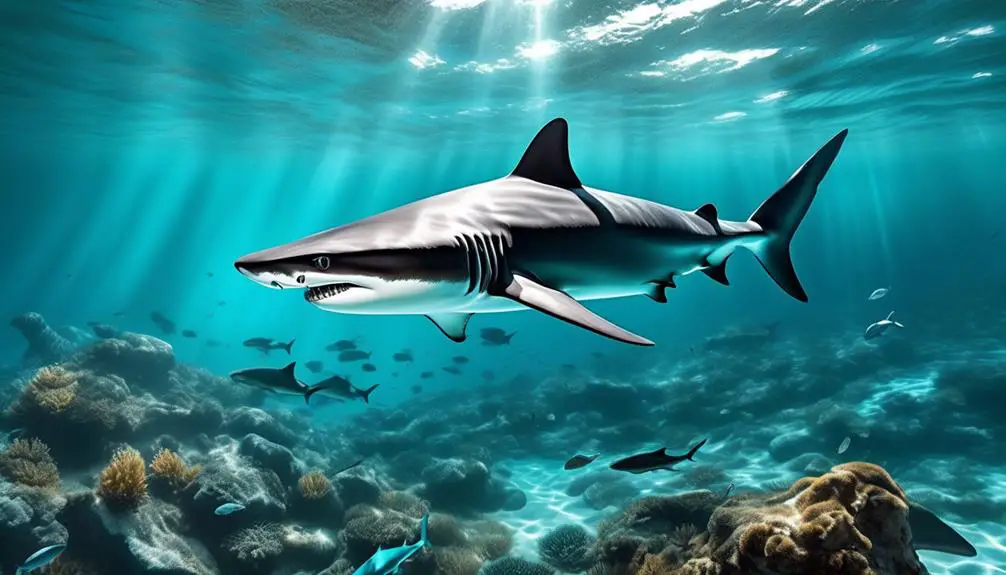
The ecological significance of Black Sea sharks cannot be overstated, as they actively contribute to the regulation of fish populations and the maintenance of a balanced food chain within this unique marine ecosystem. Sharks, such as the spiny dogfish and the common thresher shark, play a crucial role in controlling the abundance of prey species and preventing their overpopulation. This, in turn, helps to maintain the health and diversity of the Black Sea’s marine environment.
| Role of Black Sea Sharks | Importance |
|---|---|
| Regulation of Fish Populations | Black Sea sharks help control the populations of fish species by preying on smaller, weaker individuals. This prevents any single species from becoming dominant and ensures the overall balance of the ecosystem. |
| Maintenance of a Balanced Food Chain | By consuming a variety of prey species, sharks help to regulate the flow of energy through the food chain. This prevents any one species from becoming overly abundant or scarce, promoting a healthy and stable ecosystem. |
| Indicator of Ecosystem Health | The presence of sharks in the Black Sea indicates a healthy and diverse marine environment. The conservation of these sharks is vital for the long-term sustainability of the ecosystem as a whole. |
Understanding the importance of Black Sea sharks is essential for the conservation and management of this unique marine ecosystem. By studying these apex predators, scientists can gain valuable insights into the ecology and biodiversity of the Black Sea. Protecting the habitat and population of Black Sea sharks is crucial to ensure the continued balance and resilience of this fragile marine ecosystem.
Conservation of Black Sea Sharks
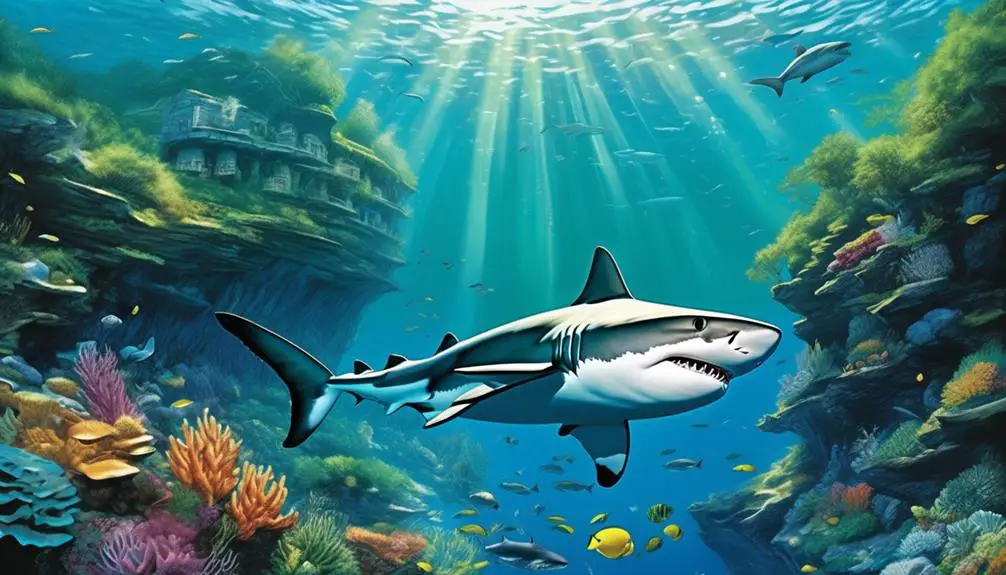
To ensure the long-term survival and ecological stability of Black Sea sharks, a comprehensive conservation plan must be implemented. Black Sea sharks, such as the spiny dogfish and common thresher shark, play a crucial role in maintaining the balance of the marine ecosystem. These species contribute to the control of fish populations and help regulate the food chain. Protecting Black Sea sharks is essential for the long-term sustainability of the marine ecosystem.
Conservation efforts should focus on several key areas. First, it’s important to establish protected areas and marine reserves where sharks can thrive undisturbed. These protected areas would provide a safe haven for sharks to reproduce and grow their populations. Additionally, strict regulations should be put in place to prevent overfishing and the accidental capture of sharks in fishing nets.
Public awareness and education programs should also be implemented to promote the importance of Black Sea sharks and their conservation. By educating the public about the ecological role of sharks and dispelling misconceptions, we can foster a sense of stewardship and support for their protection.
Monitoring and research initiatives are crucial for understanding the population dynamics, behavior, and habitat use of Black Sea sharks. By studying their movements and distribution patterns, we can better identify critical areas for conservation and implement effective management strategies.

Erzsebet Frey (Eli Frey) is an ecologist and online entrepreneur with a Master of Science in Ecology from the University of Belgrade. Originally from Serbia, she has lived in Sri Lanka since 2017. Eli has worked internationally in countries like Oman, Brazil, Germany, and Sri Lanka. In 2018, she expanded into SEO and blogging, completing courses from UC Davis and Edinburgh. Eli has founded multiple websites focused on biology, ecology, environmental science, sustainable and simple living, and outdoor activities. She enjoys creating nature and simple living videos on YouTube and participates in speleology, diving, and hiking.
🌿 Explore the Wild Side!
Discover eBooks, guides, templates and stylish wildlife-themed T-shirts, notebooks, scrunchies, bandanas, and tote bags. Perfect for nature lovers and wildlife enthusiasts!
Visit My Shop →
